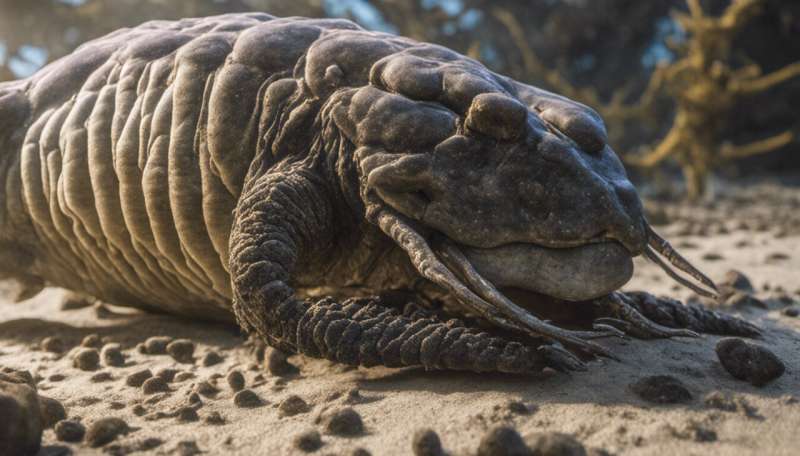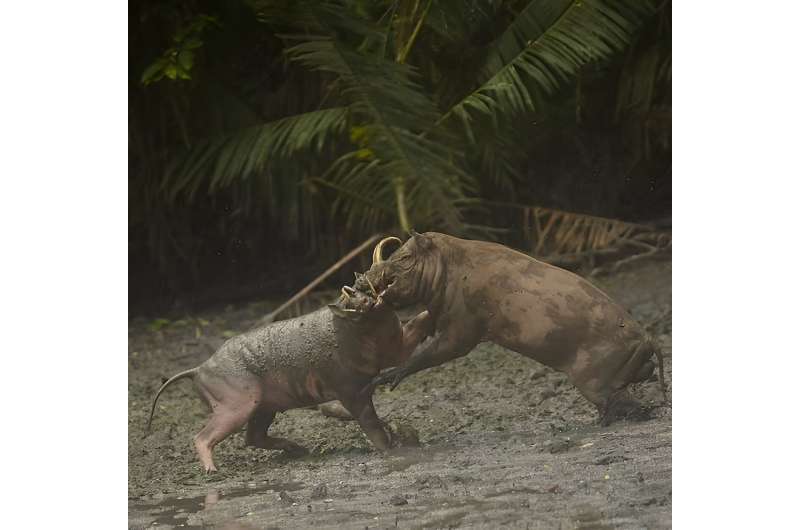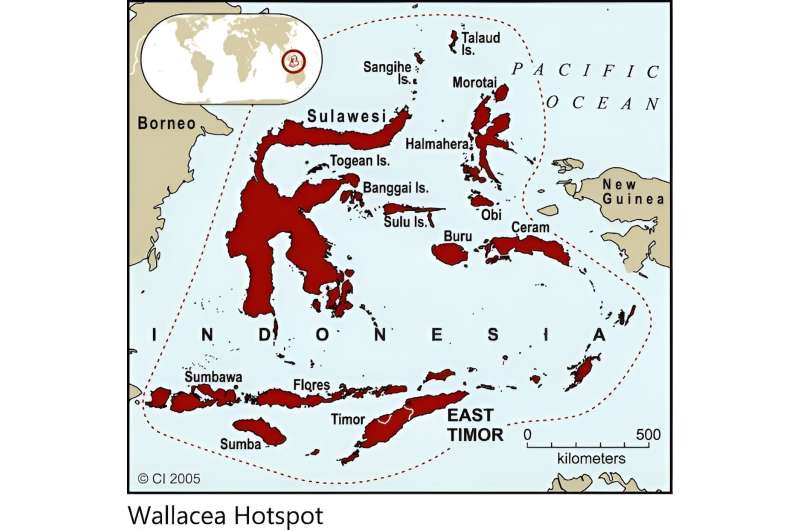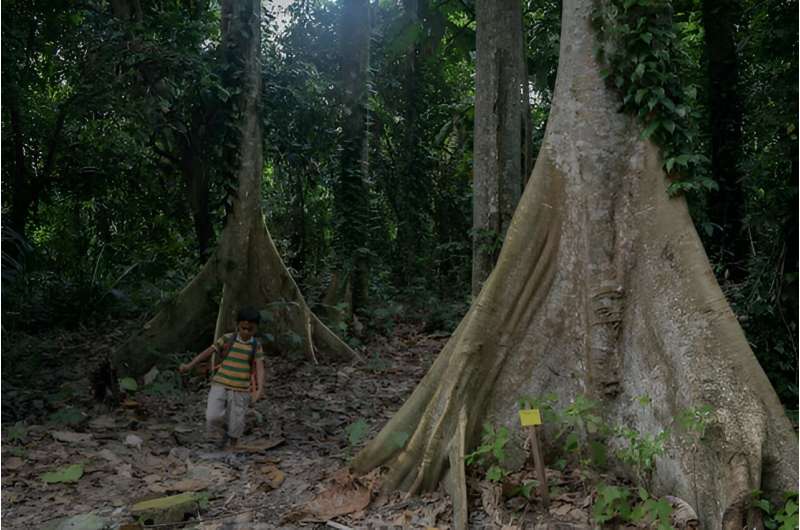This article has been reviewed according to Science X's editorial process and policies. Editors have highlighted the following attributes while ensuring the content's credibility:
fact-checked
trusted source
written by researcher(s)
proofread
Wallacea: A living laboratory of Earth's evolution. Its wildlife, forests and reefs will be devastated if we don't act

Wallacea is a fascinating region of both land and sea. Spanning approximately 338,000 square kilometers within Indonesia, it is home to a rich diversity of animals and plants, with hybrid species from both Asia and Australia/Papua regions.
There you will find hundreds of bird species, small to medium-sized mammals, primates, reptiles, and various plants—some of which are unique and found nowhere else on Earth.
Take a look at incredible species such as the komodo dragon, anoa, tarsier, babirusa, and giant bees. These animals are native to the scattered islands of Wallacea. That's before you even start to explore Wallacea's marine wonders as a part of the Coral Triangle, an area well known for its extraordinary marine biodiversity.
I have been researching this unique region of Earth for decades—and I am deeply concerned about how increasing human activities from mining, agriculture and infrastructure development threaten its delicate ecosystems.
How the region got its name
Wallacea stretches from the islands of Lombok and Sulawesi in the west to the Maluku islands in the east. Its northern boundary begins at the Talaud Islands (North Sulawesi) and reaches down to Rote Ndao Regency in the south—in East Nusa Tenggara Province, near Australia. This imaginary line defining its boundaries is known as the "Wallacea line."
Alfred Russel Wallace, the British naturalist, was the first western scientist to explore the biodiversity in this region. He documented his journey alongside hundreds of assistants through his magnum opus "The Malay Archipelago." This year marks the celebration of 200 years since Wallace's birth in January 1823.
Two centuries have passed since Wallace's work, and the Wallacea region has drastically changed from what the naturalist once observed.

The impact of global demand for palm oil and batteries
For the past four decades, I've conducted numerous studies in the Wallacea region. I explore the lives of primates and the tiniest of mammals, the tarsiers, scattered across both large and small islands.
Back then, the forests around Sulawesi, Maluku, and the surrounding islands were relatively untouched. During that time, deforestation was more prevalent in Sumatra and Kalimantan. It occurred primarily due to foreign investments in Indonesia for forest logging concessions and the establishment of oil palm plantations.
However, eventually, Wallacea was also affected.
From palm oil plantations in West Sulawesi to land clearing and development, changes driven by human activities continue to flourish in the region.
My research has found Sulawesi lost approximately 10.89% of its forests during the period from 2000 to 2017—equivalent to around 2.07 million hectares.
During that time, West Sulawesi and Southeast Sulawesi experienced the highest rates of deforestation, losing both 13.41% and 13.37% of the forest cover.
Over the past ten years, numerous companies have flocked to small islands in Maluku and around Sulawesi. These companies have cleared forests and other ecosystems to make way for palm oil, cocoa and chocolate plantations.

Nickel mining also became a prevalent industrial activity in these areas, due to growing demand for nickels as a raw material for electric vehicle batteries. Wallacea is home to the world's largest reserve of nickel.
While nickel mining has been taking place for many decades, it used to be limited to specific regions, such as the eastern part of South Sulawesi Province.
Nowadays, miners are excavating lands in many parts of Sulawesi and its neighboring islands without adequate environmental measures. Some miners even dispose of their tailings—waste materials leftover after mining—into the ocean.
Tarsiers, birds and reefs are all at risk
Alongside mining and plantations, the Wallacea is buzzing with National Strategic Projects—infrastructure projects prioritized by the Indonesian government.
There are more than 40 infrastructure projects underway, including dams, roads, railway systems, oil and gas initiatives, and many others.
The pace of development is truly striking and its effects to environment is so apparent.
In the ocean, valuable ecosystems like coral reefs have suffered extensive damage as a result of overfishing and destructive practices.

On land, massive deforestation has caused a reduction in bird species diversity as well as put monkey and tarsier populations at risk due to massive deforestation. Furthermore, deforestation has contributed to a decline in plant biodiversity.
Working together for a better future
The world must pay careful attention to the future of the ecosystems in Wallacea. Without serious conservation efforts, millions of hectares of forests in this region could transform into desolate wastelands. The vibrant coral reef ecosystems may become underwater graveyards, abandoned by marine life.
Apart from curbing deforestation, Indonesia and the world must work together to tackle climate change, which triggers rising sea levels that can put the low-lying islands of Wallacea at risk of submergence.
To ensure the future of Wallacea, all stakeholders—including the Indonesian government, scientists, mining and plantation companies, tourism industries and local communities—must collaborate.
Aiming to facilitate the collaboration, we are organizing the 2023 Wallacea Science Symposium in mid-August in Makassar, South Sulawesi Province.
This symposium has two main goals: to highlight the wonders and distinctiveness of Wallacea, and to facilitate strategic planning for sustainable development to protect this amazing ecosystem. We're hoping this event grabs more public interest and gets everyone working together to come up with fresh ideas for keeping it all preserved.
Provided by The Conversation
This article is republished from The Conversation under a Creative Commons license. Read the original article.![]()





















